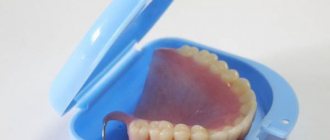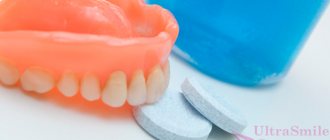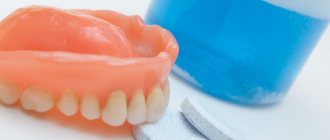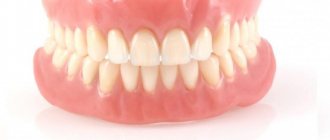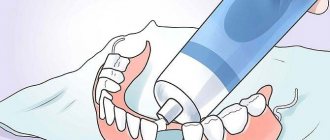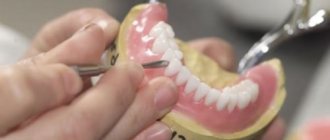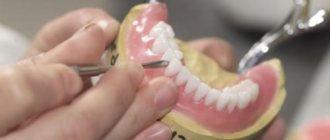Reasons What to do?
When do you need to see a doctor urgently? Methods of treating gums Solutions Advantages of prosthetics on implants Prevention Doctors Work Removable dentures solve many problems: functional (chewing, diction), aesthetic (smile), psychological (no fear of communication). But it also has disadvantages. Unpleasant sensations caused by the gums being rubbed by the denture.
You should not immediately blame the orthopedist; over time, the relief of the oral cavity changes. Due to the absence of teeth, bone tissue atrophy increases, the gums sag, fixation is disrupted, and as a result, correction or a new product is required.
Reasons why removable dentures rub
Even a well-made removable denture takes some getting used to. A foreign object in the mouth causes psychological problems and can also scratch and irritate the gums. Therefore, correction requires several visits, and adaptation – several weeks. But sometimes correction doesn't help.
Removable dentures rub when:
- The manufacturing technology was violated
: the technician did not polish well enough or did not notice the growth, which irritates the mucous membrane and causes discomfort. - The design is poorly fitted
. - The patient has untreated gum disease
: periodontitis can cause the gums under the dentures to become inflamed; it not only provokes inflammation, but also changes the contour of the gums when they swell.
- Gum recession:
due to bone tissue atrophy, trauma, unsuccessful treatment, the gums “sag” and the structure is no longer suitable.
- Service life:
over time, the base becomes covered with microcracks and roughness, which have an irritating effect.
Recommendation #4. Get dental implantation, that is, change your removable denture to a better solution
If you are tired of many uncomfortable moments (and this is not only rubbing of the mucous membranes, but also impaired diction, the inability to eat your favorite foods, the gag reflex, and others) that arise when using removable devices, then it’s time to move to a fundamentally new and higher quality level of life.
Typically, removable systems are worn by people with multiple and complete edentia (when there are no teeth at all). For such patients, the best and most correct solution is to replace removable devices with non-removable ones, fixed on analogues of the roots of natural teeth - implants. And one-stage implantation with immediate loading will help achieve this goal.
When implanted with immediate loading, the prosthesis is installed within 3 days
This approach is good because the patient receives a permanent and fully functional prosthesis, which is securely fixed in the oral cavity already 2-3 days after the implantation of artificial roots. One-stage implantation protocols make it possible to do without bone grafting and without mucosal grafting, and these manipulations in most cases are necessary for those who have used removable dentures for a long time.
Fixed structures, which are fixed to implants according to one-stage treatment protocols, have a beautiful gingival contour, as well as a metal base that stabilizes and unites the entire system into a single whole. Due to this, already during the rehabilitation period the patient begins to eat his favorite foods, smiles freely, and does not worry that the structures will fall out or rub the mucous membrane.
What to do if your denture rubs your gums
Discomfort, burning, and pain should not be tolerated; you should immediately contact an orthopedist. Inflammation of the gums under the prosthesis causes improper fitting, unreliable fastening, periodontal disease, as well as:
- Poor hygiene.
Whether it is a complete denture or a partial one, care for the oral cavity and the product itself must be thorough so that pathogenic microflora does not provoke disease. - Refusal to sanitation
of the oral cavity and dental treatment before prosthetics. Plaque and carious cavities are breeding grounds for microbes, so professional cleaning and treatment are prerequisites for a positive result. - Allergic reactions
. If acrylic is used in the design, then the symptoms may be a manifestation of an allergy to the monomers that are part of it.
First you need to eliminate the cause, and only then adjust the prosthesis; only an orthopedic doctor can do this professionally.
Comments
What happens if you continue to endure pain? My grandmother wears a removable denture and complains that it has been rubbing a lot lately, but we can’t find convincing arguments for her to finally go to the doctor...
Vera Anatolyevna (10.13.2020 at 21:15) Reply to comment
- Dear Vera Anatolyevna, if you do not take any measures to eliminate the problem, then very painful ulcers will form in the area of rubbing the mucous membrane, and an acute infectious-inflammatory process may also occur, which will gradually lead to necrosis, that is, the death of cells and tissues, osteomyelitis and phlegmon. Systematic tissue trauma can also become a prerequisite for the development of oral cancer.
Editorial staff of the portal UltraSmile.ru (10.15.2020 at 09:27) Reply to comment
How can you generally avoid such situations when the prosthesis begins to rub your gums?
Antipeev Yu.M. (10/31/2020 at 5:17 pm) Reply to comment
- Firstly, only undergo prosthetics from experienced orthopedists. Secondly, when using the prosthesis, follow these rules: after eating food, remove the prosthesis and clean it thoroughly, and rinse your mouth. If discomfort occurs and it does not go away for a long time, consult a doctor who will examine and correct the product. It’s even better if you visit a specialist every six months, undergo preventive examinations and professional hygiene, because artificial teeth require no less attention than natural teeth. And one more piece of advice: if you wear removable dentures, do not forget about dietary restrictions, refuse to eat hard, tough, viscous foods.
Editorial staff of the portal UltraSmile.ru (06.11.2020 at 09:38) Reply to comment
Hello! My dad recently received a removable denture. He says that everything is fine and suits him, like you need to get used to it. But at the same time, it hurts a little to close your jaw, and to eat too. Tell me, should this go away, or is there something wrong with the prosthesis?
Stanislav P. (11/20/2020 at 7:37 pm) Reply to comment
Good evening! Please tell me, are there any contraindications for installing a fixed prosthesis? Can a person develop an allergy to metal during such a procedure?
Anna Novikova (11/20/2020 at 7:39 pm) Reply to comment
Hello! My mother is 72 years old and had dentures installed last year. Everything was fine, but in September he flatly didn’t want to put on implants. He says they are rubbing it. They wanted to take her to the dentist, but now she has a migraine. Question: why did the dentures begin to rub only after almost a year?
Erica (11/20/2020 at 7:58 pm) Reply to comment
Only periodic adjustments will save you from chafing. Because the area of removable teeth can put pressure on the gum in some area. The only option is to cut it down. Then it will be a little easier.
Anton (11/20/2020 at 09:34 pm) Reply to comment
What can you do if after three months you still have discomfort from wearing removable dentures? Sometimes inflammation also appears. Is it possible that the design itself will have to be redone?
Inna (11/20/2020 at 9:46 pm) Reply to comment
Write your comment Cancel reply
Symptoms that require immediate medical attention
Patients often think that if their gums hurt under dentures, then this is normal, so they delay going to the doctor. Swelling and redness appear on the gums. If nothing is done at this stage, erosions and ulcers appear on the mucous membrane. Traumatic (prosthetic) stomatitis develops; drug treatment is needed.
Constant mechanical irritation leads to the formation of papillomas, which can degenerate into tumors.
Burning, discomfort, and unpleasant sensations are sometimes caused by common diseases: diabetes, alcoholism, immunodeficiency states. If you have teeth, in such cases it is better to install clasp dentures, and if this is not possible, then plate products with a soft layer under the base. The soft layer is also used if the palate is rubbed with a prosthesis.
How to sharpen a removable denture at home yourself
What household utensils could be suitable for such a delicate task? Use glass, ceramic or metal MANICURE FILES. The abrasive surface and straight shape of the file will easily remove the elongated edge or the curled edge of the dental plate directed towards the injured gum.
As a rule, over time, chafing occurs on old dentures, precisely at the border, that is, during the correction process the length of the denture is reduced.
But on newly made plates, unexpected pain occurs inside. When handing over a prosthesis, specifically a partial one, the doctor always uses a milling cutter to remove visible undercuts in the plastic. Then, during the adaptation process, abrasions appear on the mucous membrane of the jaw, which are visible to the eye and therefore removable.
Gum treatment methods
Manipulations depend on the reason:
- in case of allergic reactions, the base is changed to hypoallergenic (nylon, AcryFree), antihistamines are prescribed;
- for papillomas, excision surgery is performed;
- when a removable denture rubs, a correction (relining) is made;
- if the crown falls off, it is soldered back.
To soothe gum inflammation, ointments, infusions and lotions are used.
Pharmacy products:
Kamistad, Metrogyl Denta, Solcoseryl, Cholestal, Asepta. These gels and pastes have analgesic and anti-inflammatory effects. Before applying them to your gums, read the instructions carefully.
Disinfectant solutions:
chlorhexidine, furatsilin, destroy pathogenic flora.
Home remedies:
applications of sea buckthorn and rosehip oil. Rinse in the form of infusions of sage and plantain. Solutions of soda and salt also soothe irritation in the mouth.
How to treat chafing from dentures
Dentures are rubbing, what should I do? The main thing is not to be discouraged and do not give up. Don't think that other people haven't experienced this phenomenon. However, there is a way out in such a situation. Most often, the following measures can help combat denture chafing:
- Independent “editing” of the prosthesis. Most patients are in no hurry to see a doctor immediately if the prosthesis begins to rub. Here our enterprising people begin to use improvised means such as a small file or sandpaper. Sometimes these methods are effective, especially if the excess plastic on the prosthesis is located at the edge. After cutting off the excess thickness of the plastic base of the prosthesis, it is passed on top with sandpaper for polishing. But with this “home” method, one must be extremely delicate so as not to permanently damage the prosthesis or render it completely unusable.
- Contact the dentist. Many patients who experience pain from chafing while wearing a “removable jaw” seek advice from a doctor who has been involved in the manufacture and installation of dentures. If the prosthesis has just been made, then it would be better to contact a specialist the next day after installation, and then usually several corrections are required over the course of two weeks. It is important, after installing the dentures, not to take them off at night for at least 2 weeks to get used to it as quickly as possible. Some people have to seek correction of their “jaw” up to 10 times, which is quite normal and justified. The main thing here is to achieve maximum patient comfort when wearing these structures.
- How to behave before visiting the dentist. Of course, when the pain in the mouth becomes unbearable, the patient will no longer try to wear the denture. Don’t forget to place the removed dental structure in a disinfectant solution. However, it would be wrong to come to the doctor with the prosthesis removed, as this will not allow identifying the cause of the discomfort. Experts advise overcoming the pain and wearing the structure for at least 3-4 hours so that a clear imprint is formed on the oral mucosa. This will allow the orthodontist to more accurately adjust the dental structure using mechanical action. Most often, special tools such as a carbide cutter are used. After correction, it is better to remove the prosthesis for one day. In this case, it is advisable to rinse with herbal decoctions (calendula, oak grass, yarrow, chamomile, sage) and lotions made from them.
- Use of medicinal oils. Applications with sea buckthorn or rosehip oils are quite helpful for various wounds and abrasions. Oil-moistened wipes should be applied to painful areas for 15-20 minutes three times a day. At this time, the “removable jaw” must be removed.
- Plates. Farmadont collagen plates for gums help with abraded gums. They are often used after mechanical impact on the prosthesis. The plates are applied to painful areas of the mucous membrane three times a day until completely dissolved. Pharmadont plates contain collagen, medicinal plants, and enzymes. They relieve pain and accelerate the regeneration of abrasions.
- Use of gels and creams. Often, after eliminating the cause of chafing, doctors prescribe the following medications: “Kamistad”, “Cholisal”, “Solcoseryl-dent”. It is especially important to use them if prolonged rubbing of the prosthesis has led to the formation of ulcers.
- Sometimes ulcers form at the site where removable structures are worn. They are usually small and can sometimes bleed. More often, ulcers form on the edge of the prosthesis bed. When infected, they may become coated or bleed. If you do not react to their presence, the ulcers can become chronic. The main condition for the treatment of mouth ulcers is the perfect fit of the prosthesis with the elimination of any defects. After adjusting the structures, the ulcers quickly heal.
Attention: if treatment of mouth ulcers does not produce results after 2-3 weeks, consult an oncologist regarding these formations.
- Treatment with honey. Some patients use honey for local treatment of chafing, especially smearing it at night, or propolis tincture diluted in water for rinsing.
- Tantum Verde perfectly eliminates the effects of chafing. It relieves inflammation and pain in the oral cavity. The medicine is used in the form of rinses, sprays or lozenges.
Advantages of prosthetics on implants
- Bone tissue does not decrease, the facial contour is preserved, the smile looks younger;
- the supporting teeth do not deteriorate;
- any number of teeth are restored;
- immediately after implantation, a temporary prosthesis or a permanent ceramic-composite structure is put on (using the Resmile method);
- there is no problem with suction (as in removable ones), the structures are fixed with screws or dental cement.
Work of ROOTT dentists on implant prosthetics for periodontal disease
Stock
-27%
Teeth in 1 day on Straumann implants using ProArch technology!
300,000 rub. 220,000 rub.
get -17 %
Quadrotti dentures (without palate) 60,000 rub.
50,000 rub.
get -9 %
BASAL COMPLEX - Restoration of teeth on 1 jaw in 3 days 330,000 rub.
300,000 rub.
get -67 %
All-inclusive tooth extraction!
3000 rub. 1000 rub. get
Prosthesis adjustment in the clinic
The best treatment for swelling, calluses and gum abrasions will be prescribed by your attending physician. Don't hesitate to contact him for advice. Adjustment is a delicate matter, it’s worth going again rather than suffer from pain.
It is better not to remove the denture 3-4 hours before a visit to the dentist, even if you are very uncomfortable wearing it. This is necessary so that the doctor can see how the device is imprinted on the palate and understand which side needs correction.
We strongly do not recommend grinding the device yourself. Even if you think it's easy. Any rough intervention can ruin the prosthesis completely, not to mention the fact that you won’t be able to wear it comfortably.
Prosthesis correction in the clinic
Some sites give “good” advice to try to file around the edges yourself. Disservice. Only an adjustment in a dental laboratory guarantees that the structure that rubs the mucous membrane will be adjusted correctly.
What to do when rubbing
If an inflammatory process occurs under the prosthesis, you should consult a doctor. Only an experienced specialist can determine the cause of tissue damage and prescribe effective treatment.
Most often, rubbing of the mucous membrane occurs due to the irregular shape of the prosthesis. In such cases, the specialist performs adjustments or sharpening of the product. With the help of special tools this is done carefully and gradually. On average, a complete fit takes up to 10 visits.
In extreme cases, in case of severe inflammation or an allergy to the material, a complete change of the prosthesis is performed.
Some patients try to adjust the prosthetic structure on their own using available tools. As a rule, this leads to damage to the prosthesis or even greater injury to the gums.
In addition to adjusting the prosthesis, various medications are prescribed to relieve inflammation and accelerate tissue regeneration.
Main features
In the first month after installation of the prosthesis, discomfort is considered normal. During this period, the body gets used to the foreign body in the oral cavity.
However, if the pain does not go away for more than 2-3 months, you should consult a doctor. In such cases, there is a high risk of developing inflammation between the denture and the gum.
Characteristic symptoms are:
- redness of the gums;
- swelling of the tissue around the prosthesis;
- bleeding gums;
- pain;
- formation of ulcers or erosions in the oral cavity;
- increased body temperature;
- bad breath.
Painful sensations spread to the entire oral cavity, making it difficult for the patient to eat and even talk.
General health worsens - appetite disappears and sleep is disturbed. The severity of symptoms indicates the severity of the inflammatory process.
How to care for dentures
It is very important to understand that in the absence of high-quality and regular oral hygiene, dentures can serve as a favorable springboard for the development of harmful bacteria. Which have an extremely negative effect on the structure and can cause inflammatory processes. To avoid these consequences, you should follow fairly simple rules for caring for dentures:
- When removing, soak the structure in a special disinfectant liquid. These can be tablets, sprays or special solutions. Modern pharmacy offers a large number of options for care products. The procedure will preserve functionality and whiteness.
- It is a mistaken belief that when installing dentures, they do not need to be brushed like teeth. In fact, this is not true. Denture hygiene must also be carried out twice a day.
- Be sure to clean your dentures after eating with special products or plain water.
- Whatever designs you wear, be sure to visit the dentist at least twice a year. This will allow you to promptly identify dangerous diseases and undergo professional oral hygiene.
